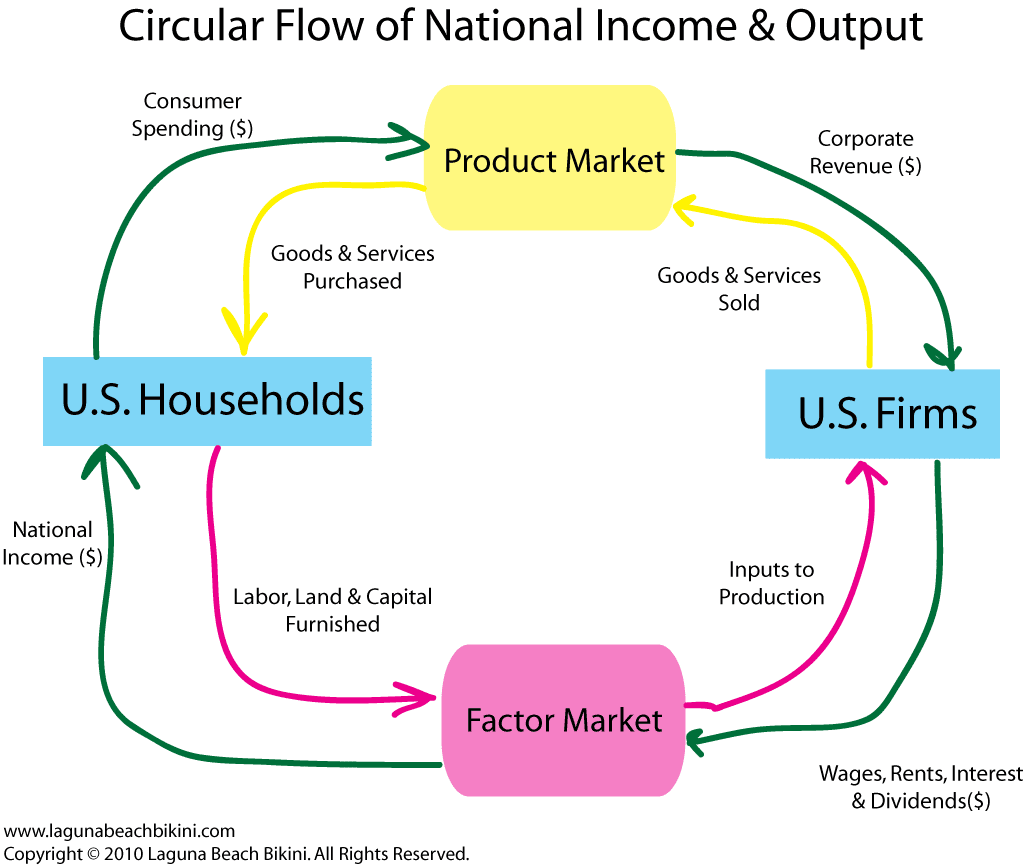

In any circular flow diagram, two flows are present, which can be thought of as two sides of the same coin. We could easily add details to this basic model if we wanted to introduce more real-world elements, like financial markets, governments, and interactions with the rest of the globe (imports and exports). This version of the circular flow model is stripped down to the essentials, but it has enough features to explain how the product and labor markets work in the economy. This is shown in the inner circle and represents the two sides of the labor market in which households supply and firms demand. All of the above are correct., In the circular-flow diagram, which of the following items represents a payment for a factor of production a. the factors of production are labor, land, and capital. the factors of production are also called 'output.' c. Households sell their labor as workers to firms in return for wages, salaries and benefits. Study with Quizlet and memorize flashcards containing terms like In the circular-flow diagram a. Bagi pemerintah, c ircular flow diagram memiliki manfaat untuk menjaga stabilitas ekonomi, mengawasi dan mengatur kebutuhan barang, sebagai media pengawasan neraca pembayaran, mengetahui pengeluaran dan produksi barang atau jasa serta. This is shown in the outer circle, and represents the two sides of the product market (for example, the market for goods and services) in which household’s demand and firms supply. Circular flow diagram merupakan hubungan timbal balik antar pelaku ekonomi dalam perekonomian Indonesia. In the diagram, firms produce goods and services, which they sell to households in return for revenues. The circular flow diagram simplifies this to make the picture easier to grasp. Also, not shown in this simple illustration of the economy are other aspects of economic activity such as investment in capital (produced-or fixed-assets such as structures, equipment, research and development, and software) and flows of financial capital (such as stocks, bonds, and bank deposits). An economy involves interactions between not only individuals and businesses, but also Federal, state, and local governments and residents of the rest of the world. The total economy is much more complicated than the illustration above. In the real world, there are many different markets for goods and services and markets for many different types of labor. That income is, in turn, spent on the goods and services businesses produce. Businesses provide individuals with income (in the form of compensation) in exchange for their labor. Alternatively, one can think of these transactions in terms of the monetary flows that occur. These activities are represented by the green lines in the diagram. In this simple economy, individuals provide the labor that enables businesses to produce goods and services. Decrease in GDP growth means that the output of an economy is still growing but at a slower rate.\)įigure 3-1: The Circular Flow by The Bureau of Economic Analysis is licensed under Public Domain. Decrease in GDP means that output of an economy is actually falling. You need to draw the Circular Arrows Diagram, Segmented Diagram or Circular Flow Diagram Any of these diagrams can be fast and easy designed in ConceptDraw DIAGRAM. You must also know the distinction between a decrease in GDP and a decrease in GDP growth. The complete circular flow diagram in an open economy shows how the economic activities are connected between different sectors. Increasing government expenditure and shrinking tax revenue.Recession occurs when GDP falls for at least two consecutive quarters, hence takes place shortly after booms/peaks (right when GDP begins decreasing):.Growing tax revenue (possibly falling government expenditure on e.g.Recovery takes place after troughs right when GDP starts growing again:.Shortage of factors of production (most probably labour).The business cycle also known as the trade cycle shows growth of an economy around the long term trend (dashed line) measured by changes in GDP.Ĥ facts to know about the business cycle:

#Circular flow diagram full
The income in the circular flow is always equal to the national income, however this equilibrium does not necessarily mean the economy is at full employment. Income going into the flow is called injections and income going out of the flow is known as leakages.Įquilibrium of national income is reached when (planned) Injections = (planned) Leakages.


 0 kommentar(er)
0 kommentar(er)
